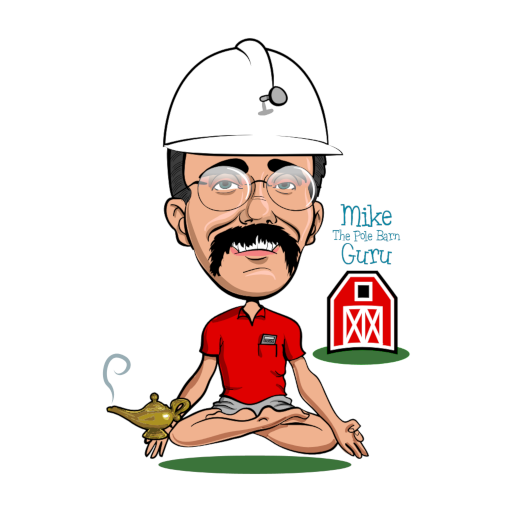So many considerations go into the proper design of horse stall barns. Having a family expert (my professional horse trainer daughter Bailey) keeps me on my toes when it comes to giving advice.
 One crucial component of good horse health is air-flow and circulation. Besides designing stall barns for good ventilation with air intakes (such as vinyl vented soffits) and an outlet (vented ridge), you must make sure you don’t impede air flow.
One crucial component of good horse health is air-flow and circulation. Besides designing stall barns for good ventilation with air intakes (such as vinyl vented soffits) and an outlet (vented ridge), you must make sure you don’t impede air flow.
A simple and cost effective method is to build what is known as a “grid barn”. The grid is formed by placing interior columns in a grid formation, aligning them with the sidewall and endwall columns. Most common is on 12 foot increments. This allows for 12 foot square stalls to be constructed, using the interior and exterior columns as corners for stalls, tack and feed rooms.
The interior columns are extended upward to meet the roof line. Rather than using trusses to support the roof system, rafters are placed to align with the columns. Depending upon snow load, these rafters may be large dimensional lumber (multiple 2×10 or 2×12 members), or Laminated Veneer Lumber (LVLs).
Actual airflow studies have shown that even “open web” prefabricated roof trusses impede the smooth air flow within a building. The use of rafters (which follow the slope of the roof) creates a clean, open interior allowing for unobstructed air flow.
Besides forming strong corners for stalls (with the columns fully tied into the roof system) and minimizing airflow restrictions, other side benefits are gained. The increased height above aisleways allows for taller doors to be placed on gable endwalls, without the truss bottom chords in the way.
The interior columns also allow for loft areas to be constructed, without being impeded by trusses. A horse barn loft can be used for hay storage, a place to put seldom used tack, or (if height allows) space for offices or an apartment.
Most common widths are 36 foot (which allows for stalls on each side of a central aisleway) and 72 foot (stalls, aisleway, back to back stalls, aisleway, stalls). Lengths are only limited by available space and budget.
When planning a new stall barn, ample consideration should always be given to a pole and raftered grid barn. It may prove to be the ideal solution to solve several problems at the same time.







Hi Mike,
Thanks for all the information you shared. I’m currently planning my pole barn and want the option to house several horses down the road. Quick question….are the interior posts countersunk/cemented into the floor or is the stall strong enough by the rest of the stall framing. Thanks for the info. If you have any other info, I’m all ears.
Thanks,
John
You are very welcome John. In the case of pole and raftered grid barns – those interior columns are embedded into the ground and then safely tied into the roof system. It is the best way to guarantee stability for your stall corners. Please feel free to reach out to me directly with any questions.
I have been working w your folks on a 40×60 for horses, interested in rafter grid. So it would be 36×60. How big would the posts be. 12 feet apart, for 12×12 stalls on both sides, how the posts attached to the rafters? How long will the interior posts be? I will be building the stalls afterwards, may only build stalls on one side and have the 5 posts on the other side avail if needed, Single or double ?I assume 2×4 purlins 2 foot on center turned ons side, don’t need center posts? How will you be attaching top of rafters together, ridge board? Live in maine. Wind and snow. Thanks so much
You could do a grid barn 40′ in width and have stalls 14′ deep or a 16′ wide aisle (my daughter would like the wider aisle). The rafters will be placed into notches cut into the columns , then nailed. Interior columns will be longer than sidewall columns by distance from eave to interior columns x slope of roof. e.g. 12′ at a 4:12 slope would be 12′ x 4″ = 48″ taller. Purlins will be 2x material placed on edge and inset between rafters with steel hangers. Rafters will butt at center.
Single or double in the rafters and how big a lumber ? 8/12 pitch
Rafter number and dimensions will be determined by the Engineer of Record.
Isn’t this close to the same as attic trusses? Which would be more cost effective? Both as strong ?
Actually not similar at all. Pole & rafter will provide superior air flow to a trussed system, will be more cost effective overall and either one will be equal in strength to whatever loads are specified.
8/12 pitch roof , columns 12 feet apart, So rafters will be 12 ft apart notched into columns and butted at ridge, W purlins 2 ft on cent. No rafters needed between columns ?